Questions and Answers: June 2015
This part of e-gardens has historically been our most popular. If you’d like to send Neil your plant question along with a photo (required), do so here. It also helps if you’ll let him know where you live, as answers will vary with parts of the state. Here are his answers to this month’s questions of the greatest general interest to our readers.
Question: My Madison jasmine has developed red spots on all of its leaves. It has been in its current location for two years, and it bloomed beautifully this spring. I have a dozen of the plants, and they all have these spots. What should I do? S., Frisco.
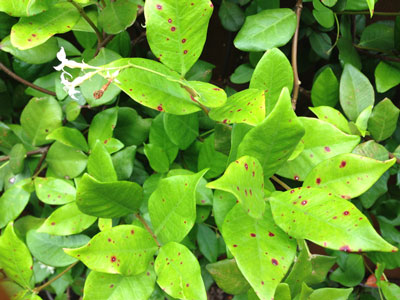
Answer: This definitely appears to be fungal. I am guessing it’s Cercospora fungal leaf spot. Daconil should give relief. This is not a common problem, at least not in my experiences with this great vine.
(Note from Neil: The following question was repeated by several other readers.)
Question: This 18-year-old live oak has sudden browning of its leaves the past few weeks. It is the only one of about 20 live oaks in our front yard with this problem. Photos were taken just a few days ago. No name given, Hill County near Lake Whitney.
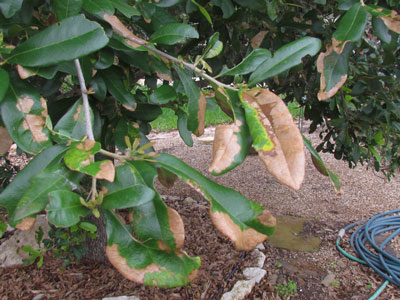
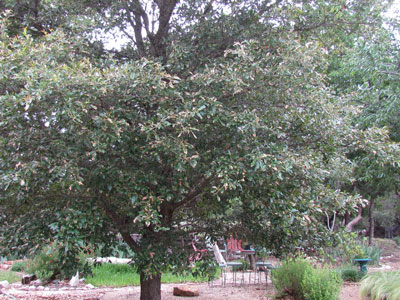
Answer: I am not certain. Marginal burn like this often points to moisture stress, sometimes related to root or trunk damage. It can also be due to gas leaks, herbicides, etc. Rather than make a lot of wild-eyed guesses, I’m going to suggest that you (a) involve a certified arborist immediately and (b) send a box filled with leaf and branch samples to the Texas Plant Clinic at Texas A&M. http://plantclinic.tamu.edu. There is also the chance that it’s a fungal issue brought on by this spring’s wet weather. Live oaks vary genetically from one tree to the next, so variations between trees in things like this are quite common.
(Note from Neil: The following question was repeated by several other readers.)
Question: These small nodules are on the leaves of our cedar elm. Are they some kind of sucking pest, and do we need to worry? M.L., Lewisville.
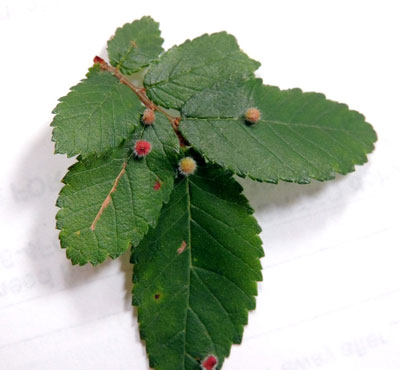
Answer: These are insect galls. Our various shade trees are actually blessed with many different types of galls, almost all of them (this one included) harmless. The adult wasp of this species stings the plant leaves and deposits her eggs. The plant tissue grows around it. There is no harm and no call to action. You couldn’t control them if you wanted to.
Question: Our 1-month-old Bloodgood Japanese maple appears to be dying. Its leaves are turning brown and falling off. Another identical tree on the other side of the yard looks fine. What can I do to save it? No name or city given.
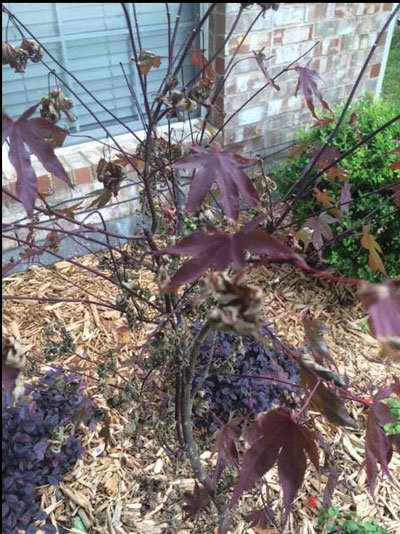
Answer: This is not due to insects or diseases. This is some type of moisture stress, and as improbable as it may seem, I’m going to suggest that this tree got too dry at some point since it was planted. The other tree apparently got through that dry time safely. Other possibilities: too much fertilizer applied near this young tree; too much exposure to highway winds on the way home from the nursery, a broken root ball at the time of planting, etc. I really can’t tell from the photo.
Question: What is wrong with my tomato plant? I’m familiar with blight, but it doesn’t hit until later. What can I do? D.R., Azle.
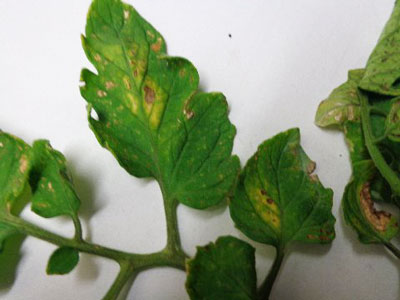
Answer: This is early blight, and we’re seeing it even earlier than usual this spring due mostly to the wet weather. Apply a labeled fungicide as soon as possible. Repeat on 7-day intervals until the problem abates. Sun and warm weather will help.
(Note from Neil: The following question was repeated by a dozen or more other readers.)
Question: My St. Augustine has these dead spots. What causes it, and what can I do? J., no city given.
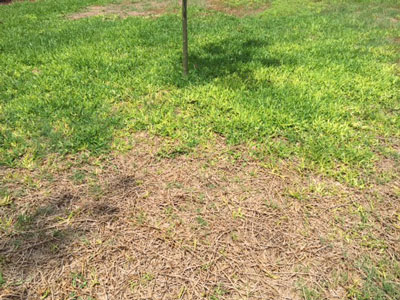
Answer: This is almost assuredly take all root rot, and it looks like a rather serious outbreak. It’s unusual for it to leave such a big area completely lifeless. I’m assuming the grass looked good going into the winter. Rather than try to redo all the information on TARR, here is what I have in the FAQ pages of my website: https://neilsperry.com/faq/my-st-augustine-looks-like-it-is-fading-away/
Question: What is this on my rose bushes, and do I need to worry?
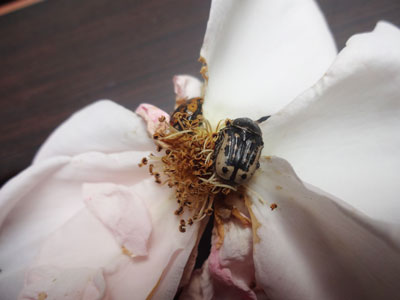
Answer: I had a flurry of questions about this pest a few days ago. I asked Dr. Mike Merchant of the Texas A&M AgriLife Extension Service about it. He, too, had been getting numerous inquiries. Here is what he put together. http://citybugs.tamu.edu/2015/05/06/kerns-flower-scarab/
Question: We planted these pines in the Blackland Prairie 15 years ago. Their tops still look healthy, but the bottoms do not. Do you have any suggestions? J.C., east of Temple.
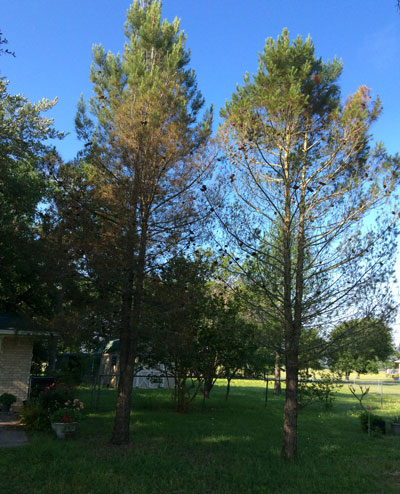
Answer: We who live in the Blackland clay soils have a difficult time getting any pine to survive. These look like Eldarica pines, and my observations of Eldaricas in the DFW area and elsewhere in the Blackland Prairie have been that they do not do well in periods of prolonged wet soils. They are native to Afghanistan, where rainfall is 10 inches or less. I’ve seen hundreds of them die, just like this, months and even a couple of years after heavy rains. The new growth does look good, but I fear that even if you can save them, their lowest branches would be so far off the ground that the trees would never look right. I have just all but given up on pines outside of their native areas of loblolly pines in East Texas and piñon pine in West Texas.
Question: What is causing the tips of my Bradford pear’s branches to turn dark brown? K.E., Pflugerville.
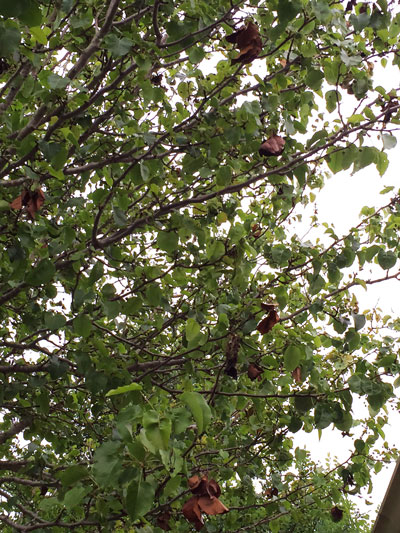
Answer: This is fire blight. It’s a spring bacterial disease that is carried by bees as they visit the flowers. You can spray while the plant is in full bloom, but make that spray late in the evening, after the bee activity has stopped. Apply agricultural streptomycin that one time each year. If you still see branches that are impacted, cut them out with a pole pruner. Disinfect the cutting head between each cut by dipping it into a bucket of 90 percent water and 10 percent chlorine bleach. Cut beyond the dead tissue into healthy wood.
Question: What is wrong with my magnolia tree? When we bought our house two years ago, the tree was in terrible shape. I pruned out two dead limbs and took good care of it. It did well until this spring, and then a lot of its leaves turned blotchy and started falling off. Is there something I can do to help it? D.H., McKinney.
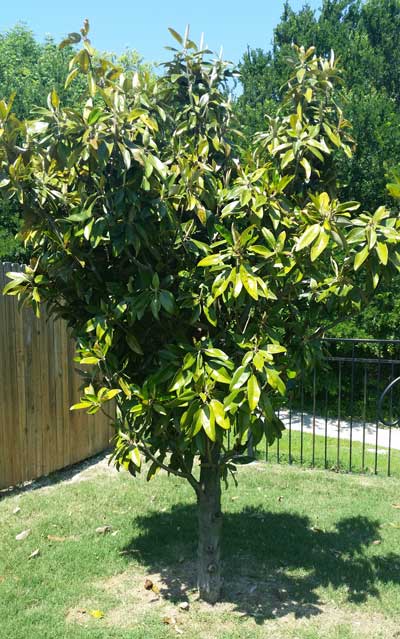
Answer: I think you have just been seeing the old leaves from last year as they have been falling and then replaced with new leaves. I do see healthy new growth at the tips of the branches in your photo. Apply an all-nitrogen lawn fertilizer (no herbicide included) to the tree after the soil dries out a bit. The scorching and leaf drop were more pronounced this year than most. Your tree should be just fine.
(Note from Neil: The following question was repeated in variation by several other readers.)
Question: When I returned from a 15-day vacation last August, my crape myrtle had lost half of its leaves. (I assumed it was from my son-in-law not watering it.) As you can see, a large portion of the plant has been slow to leaf out. What should I do? C.M., Nevada TX.
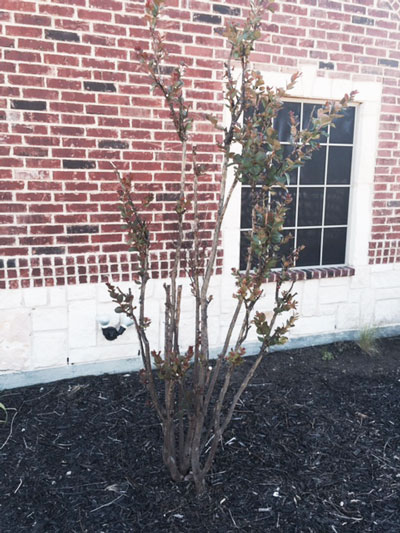
Answer: This is winter damage, and there has been a huge amount of it across Texas. You may have seen the repeated posts on this damage on my Facebook page. The easiest solution is to cut the plant back completely to the ground and let new sprouts emerge. They will be more vigorous than these shoots, and you will be able to retrain them into tree form very quickly. Keep an eye out, too, for white scale insects that adhere to the trunks. A systemic insecticide applied as a soil drench now is the best remedy.
Question: I have five tissue-cultured banana plants in pots on my patio. I’m concerned about summertime and whether twice-daily watering will keep them going. How can I maintain their tropical look and keep them healthy and happy? C.M., Bedford.

Answer: (Lovely landscape.) There are many types of bananas, some growing much larger than others. Your goal with container plants is to have them growing in pots that are one-third to one-fourth the height and width of the plants. Bananas can grow very large, so it wouldn’t surprise me if you have to replant these into much larger pots by mid-summer. Remember, too, that these will not be cold-hardy come next winter. If you leave them in pots, you’ll have to get them into protection when temperatures drop. Bananas typically die to the ground with the first freeze. That usually doesn’t kill them, but normal winter lows in the teens and 20s probably would. Hope that helps.
Question: This plant came up as a volunteer beside our mailbox last year. It grew quickly to 30 inches tall, so I cut it back. Now it’s there again, only bushier. Should I leave it? S., Weatherford.
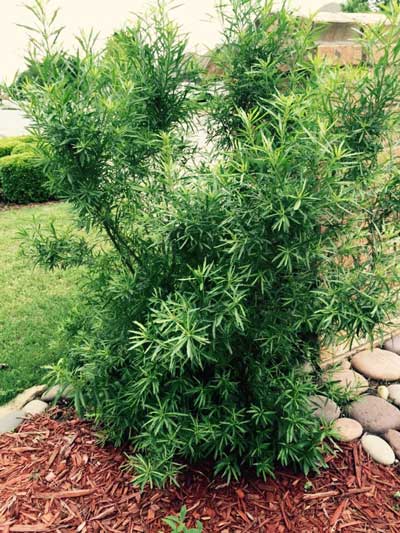
Answer: I have zoomed in as best I can, and I’m pretty sure this is false Japanese yew (Podocarpus). It’s a great evergreen shrub that’s much more commonly used in South Texas. It’s hard to picture it coming up as a random volunteer near Weatherford. I would leave it, at least until winter. You could transplant it at that point to a location where you could protect it from extreme winter cold, also where it could grow to 6 or 8 feet tall. (They grow much taller in South Texas.)
Question: I have crape myrtles that are 15 years old. They are still trying to put out new shoots at their bases. Is there any way to stop this? K.C., no city given.
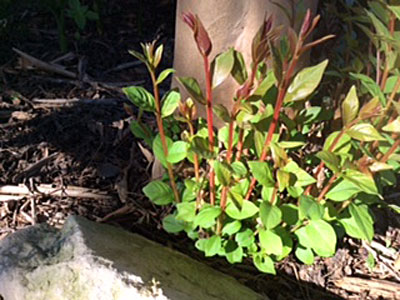
Answer: Be sure the top growth is healthy and vigorous and that there was no freeze injury this past winter. (See question on that topic above.) If you have to cut the plant back to the ground, these shoots would be your new trunks. If the tops look healthy, however, you can easily rub these away with a gloved hand if you do so immediately. If you have to trim them off, cut them flush with the trunks. Crape myrtles do eventually give up this habit.
Question: We planted two red oaks a couple of years ago. One has really odd branches that don’t seem to want to grow upward. Can I prune them to encourage normal growth, or should I just replace it? (Photo from winter to show you the branches.) V., no city given.
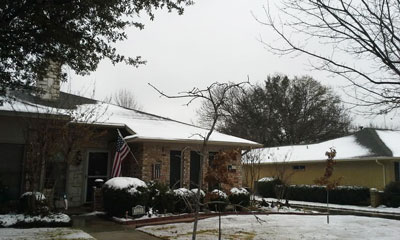
Answer: I’d probably try rather extreme pruning to remove most of that horizontal growth from both of those top branches. You might also want to remove the lowest branch on the right. Give it an all-nitrogen fertilizer and keep it watered well during the summer. See how it looks by next winter. At that point, if it’s still odd, you can replace it.
Question: I have not been satisfied with my dwarf wax myrtles. I replaced one with a Carissa holly. What other hollies could I use beneath the windows? T.C., Parker County.

Answer: I would suggest using two or four more Carissa hollies in the bed (so you’ll end up with an odd number of them). You could also use Harbour Dwarf, Harbour Belle or Flirt dwarf nandinas as a groundcover for a little difference in textures.
Question: We need a shrub to grow behind our Indian hawthorns. What would stay at less than 48 inches tall? N.S., Athens.
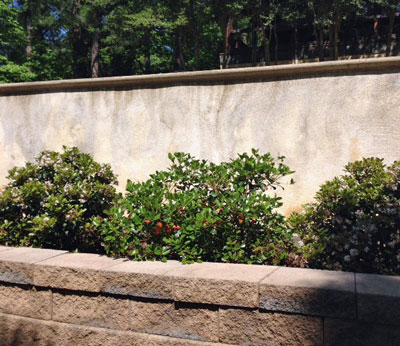
Answer: Compact nandinas (Nandina domestica ‘Compacta’) would be beautiful. They grow to 42 inches, although I keep mine at 30 to 36 inches by cutting the tallest canes completely to the ground each February and as needed during the year. That way I always have new shoots coming up in the clumps. Eventually you might have to dig and remove a few plants each year as they start to spread, but it’s an easy task. Nandina has wonderful texture and winter color.
Question: We have a large elm tree with a smaller oak beside it. I know elms don’t last as long as oaks. Should we remove the elm and leave the oak in the assumption that the elm won’t last much longer? H.H., no city given.
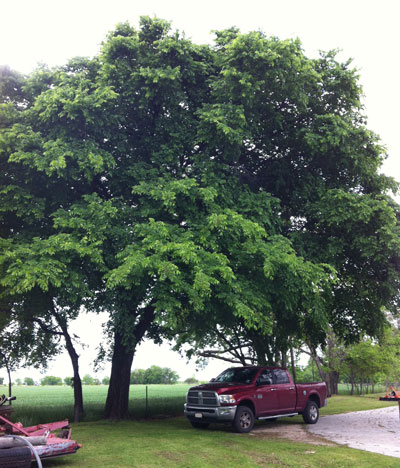
Answer: The elm looks healthy and vigorous. The oak, due to having grown in the shadows of the larger elm, is misshapen. I would certainly not remove the elm at this point. If you choose to move the oak, do so next winter. However, you might get a nicer oak a lot sooner if you were to buy a container-grown specimen and plant it wherever you might have put this one.
Question: I have three 20-foot Chinese pistachios. The trees drop fruit all over the place and make a big mess. I am not happy with them. Why do mine produce all the berries? S.B., Garland.
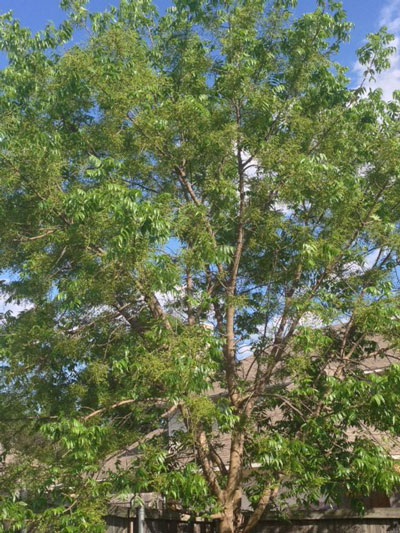
Answer: Chinese pistachio trees are either male (no berries) or female (berries). There is no way to make a fruiting pistachio fruitless. Even with the fruit, however, they are outstanding trees. Each of us living beings has at least one or two flaws, and that could be considered to be the flaw of your trees. But they’re still lovely. Hopefully you can look past it.
Question: What are these terrible things on my azaleas’ leaves? J.L., Athens.
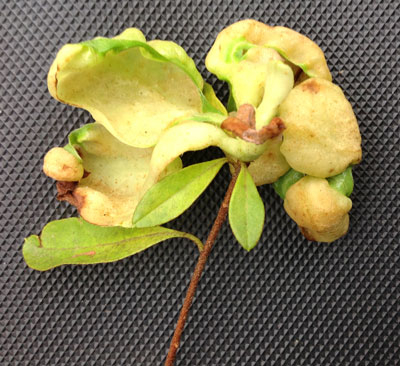
Answer: Those are galls, and they are the result of a pathogen. Normally they’re not a huge problem. In fact, I just pluck them off my own azaleas, taking care not to touch healthy leaves in the process. This spring has been perfect for their growth and development. Here is a good reference sheet from Mississippi State University: http://msucares.com/newsletters/pests/infobytes/19990415.htm

